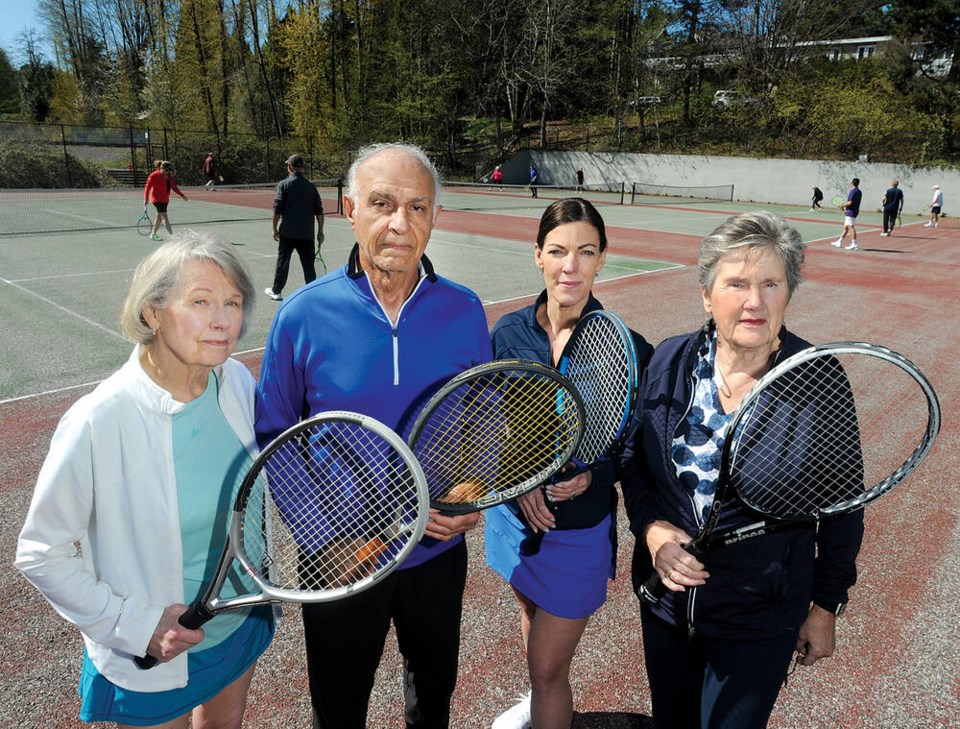Tennis players in the City of North Vancouver say they’re frustrated and disappointed that the municipality hasn't come up with a game plan to replace the municipality's rapidly vanishing tennis courts.
“There’s a particularly acute and current loss of courts,” said Duncan Brown, president of the North Shore Tennis Society, noting eight of the previous 18 outdoor public courts in the city have either been lost to redevelopment projects or are likely to be lost soon.
In the past, tennis players in the city were generally well served by the number and quality of courts available, said Brown. But in recent years, that’s changed.
Four public tennis courts were lost when the Harry Jerome Recreation Centre rebuild project started, said Brown. At one point, he said, there were discussions about putting tennis courts on the roof of the new rec centre, but when the project was revised because of financial pressures, “those were eliminated from the discussion,” said Brown.
Four tennis courts in Cloverley Park are also being lost soon as the school district moves to build its new elementary school on the site of the park, which is owned by the school district.
Tennis players have also learned that two courts at Derek Inman Park could also be lost as part of the redevelopment of North Shore Neighbourhood House.
Brown said tennis players don’t dispute that the projects that have pushed out their courts are valuable. The problem, he said, is that tennis has become “collateral damage” and no plans have been put in place to replace the lost courts.
“They’ve had multiple years to develop plans to replace these courts. And they haven’t done that,” said Brown.
Political leaders have been generally supportive, he said. But funding to address the problem has been lacking.
Instead, Brown said money that has previously been earmarked for tennis has repeatedly been cut from the budget. Two replacement courts at Loutet Park were included in a draft budget last year, for instance, but didn’t make the final cut.
This year, after tennis players lobbied city politicians, civic leaders agreed to put $80,000 towards a consultant who will assess the situation, including the condition of remaining courts, how many courts need replacing and which parks have space to accommodate the courts.
Tennis players say that money would have been better spent towards building tennis courts rather than studying them.
“I can count the number of courts on one hand and I can tell you within two minutes what the quality of those courts are,” said Brown.
“If you’re going to replace the courts get on with it,” said Cathy Still, a board member of the North Shore Tennis Society. “That to me is just a delay tactic.”
Other user groups – including skateboarders and lawn bowlers – have seemed to have a much easier time getting action from the city in replacing their facilities, including those lost as part of the Harry Jerome rebuild, the tennis players say.
“And we’re still waiting for them to even talk about tennis courts,” said Brown.
Brown said players are now worried that the need to replace tennis courts will get lost in wider studies of parks within the city, which could take years to complete.
Currently the main indoor facility for tennis is at the North Shore Tennis Centre on Lloyd Avenue. That nine-court facility is hugely popular, and very difficult to book, said Brown.
Unlike many indoor sports, tennis players pay all the operating costs through user fees, he added.
Tennis players have proposed that the city identify a site for a new tennis hub – at a location such as Sunrise Park near Park & Tilford – where six to eight new convertible indoor/outdoor courts could be built on a self-funding model.
So far, players say, the response has been muted.
In a statement, the city acknowledged both staff and council have heard from members of the tennis community about the loss of courts.
“We understand that sport users are passionate about access to the facilities they love, however, staff are looking to provide a clear, data-centred rationale to all residents and council when it comes to decisions regarding capital expenditures,” the statement read.
The North Vancouver Recreation & Culture Commission is expected to complete a sport facility plan in the fall of this year, which will include an inventory of indoor and outdoor facilities, an analysis of how much those facilities are used, a look at changing demographics and community engagement.
Funding previously earmarked for courts at Loutet Park wasn’t specifically for tennis courts, the city added – but will be guided by the results of the recreation commission’s planning process.
In contrast to the situation in the city, the District of North Vancouver has a reasonable number of outdoor tennis courts, said Brown.
West Vancouver has a 29 outdoor courts. But most of them are in the western, less-populated part of the municipality, said Marcus Shapiro, a tennis society board member.
“There are really only three tennis courts down in Ambleside by the water,” he said. “They’re highly popular.”
There also aren’t any indoor public courts in West Van, said Shapiro.
A year ago, the District of West Vancouver announced tentative plans to partner with Tennis B.C. build a tennis and pickleball facility at Hugo Ray Park. But since then, “there’s been a dearth of information and extreme tight-lippedness from West Vancouver, even though we have asked them for updates,” said Shapiro.
According to the district, “staff continue to work to explore the feasibility of that project.”


